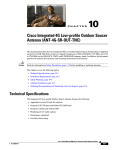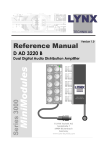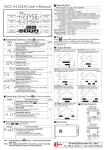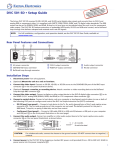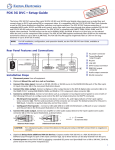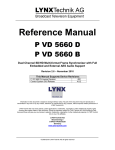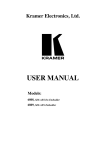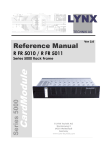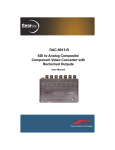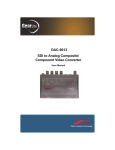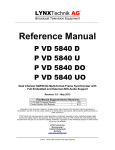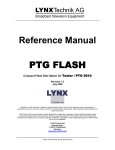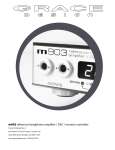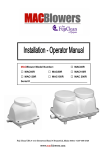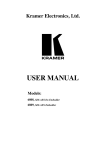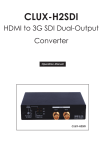Download Reference Manual
Transcript
Reference Manual C DX 3624 SD/HD Monitoring Down Converter with Embedded Audio Support and Video and Audio D/A Conversion Revision 1.2 December 2006 Information in this document is subject to change without notice. No part of this document may be reproduced or transmitted in any form or by any means, electronic or mechanical for any purpose, without express written permission of LYNX Technik AG. LYNX Technik AG may have patents, patent applications, trademarks, copyrights or other intellectual property rights covering the subject matter in this document. Except as expressly written by LYNX Technik AG, the furnishing of this document does not give you any license to patents, trademarks, copyrights or other intellectual property of LYNX Technik AG or any of its affiliates. LYNX Technik AG Brunnenweg 3 D 64331 Weiterstadt Germany www.lynx-technik.com © 2006 LYNX Technik AG all rights reserved C DX 3624 Reference Manual. Rev 1.2 Contents WARRANTY .......................................................................................................................................................................... 3 REGULATORY INFORMATION ........................................................................................................................................... 4 EUROPE ............................................................................................................................................................................. 4 Declaration of Conformity............................................................................................................................................ 4 USA .................................................................................................................................................................................. 4 FCC 47 Part 15 ........................................................................................................................................................... 4 GETTING STARTED ............................................................................................................................................................. 5 PACKAGING ........................................................................................................................................................................ 5 PRODUCT DESCRIPTION.................................................................................................................................................... 5 INPUT FORMATS ................................................................................................................................................................. 5 OUTPUT FORMATS ............................................................................................................................................................. 5 CONVERSION MODES ......................................................................................................................................................... 5 HDTV Inputs > Down Conversion ............................................................................................................................... 5 SDTV Inputs................................................................................................................................................................ 6 ASPECT RATIOS ................................................................................................................................................................. 6 Letterbox ..................................................................................................................................................................... 6 Center Cut................................................................................................................................................................... 6 Stretch to Fill ............................................................................................................................................................... 6 VIDEO PROCESSING ........................................................................................................................................................... 7 Video Proc Amp .......................................................................................................................................................... 7 Aperture Correction and Color Space Conversion...................................................................................................... 7 AUDIO PROCESSING ........................................................................................................................................................... 7 DolbyE......................................................................................................................................................................... 7 TEST PATTERNS ................................................................................................................................................................. 8 FUNCTIONAL DIAGRAM ..................................................................................................................................................... 8 MODULE LAYOUT................................................................................................................................................................ 9 CONNECTIONS .................................................................................................................................................................... 9 VIDEO ................................................................................................................................................................................ 9 AUDIO .............................................................................................................................................................................. 10 Digital Audio (AES) ................................................................................................................................................... 10 Analog Audio............................................................................................................................................................. 10 Audio Output Connections (un-balanced)................................................................................................................. 11 POWER ............................................................................................................................................................................ 11 INSTALLATION................................................................................................................................................................... 12 LOCAL CONTROL.............................................................................................................................................................. 13 LOCAL CONTROL MENU STRUCTURE ................................................................................................................................. 13 FACTORY DEFAULT SETTINGS........................................................................................................................................... 17 INDICATORS....................................................................................................................................................................... 17 ALARM INDICATOR ............................................................................................................................................................ 17 LED 1.............................................................................................................................................................................. 17 LED 2.............................................................................................................................................................................. 17 GUI OPERATION ................................................................................................................................................................ 18 MAIN TAB ......................................................................................................................................................................... 19 ANALOG VIDEO TAB.......................................................................................................................................................... 21 ANALOG VIDEO GAIN TAB ................................................................................................................................................. 25 ANALOG AUDIO GAIN TAB ................................................................................................................................................. 26 SPECIFICATIONS............................................................................................................................................................... 28 SERVICE ............................................................................................................................................................................. 29 PARTS LIST ...................................................................................................................................................................... 29 TECHNICAL SUPPORT ....................................................................................................................................................... 29 CONTACT INFORMATION ................................................................................................................................................. 29 Page 2 of 29 C DX 3624 Reference Manual. Rev 1.2 Warranty LYNX Technik AG warrants that the product will be free from defects in materials and workmanship for a period of two (2) year from the date of shipment. If this product proves defective during the warranty period, LYNX Technik AG at its option will either repair the defective product without charge for parts and labor, or will provide a replacement in exchange for the defective product. In order to obtain service under this warranty, customer must notify LYNX Technik of the defect before expiration of the warranty period and make suitable arrangements for the performance of service. Customer shall be responsible for packaging and shipping the defective product to the service center designated by LYNX Technik, with shipping charges prepaid. LYNX Technik shall pay for the return of the product to the customer if the shipment is within the country which the LYNX Technik service center is located. Customer shall be responsible for payment of all shipping charges, duties, taxes and any other charges for products returned to any other locations. This warranty shall not apply to any defect, failure, or damage caused by improper use or improper or inadequate maintenance and care. LYNX Technik shall not be obligated to furnish service under this warranty a) to repair damage resulting from attempts by personnel other than LYNX Technik representatives to install, repair or service the product; b) to repair damage resulting from improper use or connection to incompatible equipment; c) to repair any damage or malfunction caused by the use of non LYNX Technik supplies; or d) to service a product which has been modified or integrated with other products when the effect of such modification or integration increases the time or difficulty servicing the product. THIS WARRANTY IS GIVEN BY LYNX TECHNIK WITH RESPECT TO THIS PRODUCT IN LIEU OF ANY OTHER WARRANTIES, EXPRESS OR IMPLIED. LYNX TECHNIK AND ITS VENDORS DISCLAIM ANY IMPLIED WARRANTIES OF MERCHANTABILITY OR FITNESS FOR A PARTICULAR PURPOSE. LYNX TECHNIK`S RESPONISIBILITY TO REPAIR AND REPLACE DEFECTIVE PRODUCTS IS THE SOLE AND EXCLUSIVE REMEDY PROVIDED TO THE CUSTOMER FOR BREACH OF THIS WARRANTY. LYNX TECHNIK AND ITS VENDORS WILL NOT BE LIABLE FOR ANY INDIRECT, SPECIAL, INCIDENTIAL, OR CONSEQUENTIAL DAMAGES IRRESPECTIVE OF WHETHER LYNX TECHNIK OR THE VENDOR HAS ADVANCE NOTICE OF THE POSSIBILITY OF SUCH DAMAGES. Page 3 of 29 C DX 3624 Reference Manual. Rev 1.2 Regulatory information Europe Declaration of Conformity LYNX Technik AG Brunnenweg 3 D-64331 Weiterstadt Germany Declare under our sole responsibility that the product We TYPE: C DX 3624 To which this declaration relates is in conformity with the following standards (environments E1-E3): EN 55103-1 /1996 EN 55103-2 /1996 EN 60950 /2001 Following the provisions of 89/336/EEC and 73/23/EEC directives. Winfried Deckelmann Weiterstadt, November 2006 Place and date of issue Legal Signature USA FCC 47 Part 15 This device complies with part 15 of the FCC Rules. Operation is subject to the following two conditions: (1) This device may not cause harmful interference, and (2) this device must accept any interference received, including interference that may cause undesired operation. Note: This equipment has been tested and found to comply with the limits for a Class A digital device, pursuant to the part 15 of the FCC Rules. These limits are designed to provide reasonable protection against harmful interference when the equipment is operated in a commercial environment. This equipment generates, uses, and can radiate radio frequency energy and, if not installed and used in accordance with the instruction manual, may cause harmful interference to radio communications. Operation of this equipment in a residential area is likely to cause harmful interference in which case the user will be required to correct the interference at his own expense Page 4 of 29 C DX 3624 Reference Manual. Rev 1.2 Getting Started Packaging The shipping carton and packaging materials provide protection for the module during transit. Please retain the re-useable shipping cartons for a period of time in case subsequent shipping of the product becomes necessary. Please read this manual before attempting operation of the module. Product Description The C DX 3624 is a high quality multi-format monitoring down converter providing down converted digital and analog video outputs + analog and digital audio outputs. Input Formats The module has one multi-format serial digital input with automatic input detection. The module will detect the following input standards and configure the input stage automatically for operation in the connected format. SDTV Formats 525 / 59.94Hz 625 / 50Hz HDTV Formats 1080i / 59.94Hz 1080i / 60Hz 1080i / 50Hz 720P / 59.94Hz 720P / 60Hz 720P / 50Hz Output Formats The module provides analog and digital video outputs. The analog video outputs are SDTV only and the available 3 BNC connections can be configured to provide the following analog video outputs. 3 x CVBS (composite) 1 x YUV Component analog video 1 x YC (S-VHS) + 1 x CVBS (composite) Two serial digital outputs are also provided which can be configured to provide 2 x digital down converted outputs or 2 x re-clocked copies of the input signal (1>2 distribution amplifier) Conversion Modes HDTV Inputs > Down Conversion With a compatible HD source connected the module only supports down conversion between divisible frame rates. For example If a frame rate of 59.94Hz is connected to the input then the module can only output a down converted 59.94Hz output. This module will not function as standards converter. Please refer to the table below which shows compatible conversion modes Page 5 of 29 C DX 3624 Reference Manual. Rev 1.2 Input Signal 1080i / 50Hz 1080i / 59.94Hz 1080i / 60Hz 720P / 50Hz 720P / 59.94Hz 720P / 60Hz Converted Output 625 / 50Hz 525 / 59.94Hz 525 / 59.94Hz 625 / 50Hz 525 / 59.94Hz 525 / 59.94Hz Notes 59.94Hz output will drop frame 59.94Hz output will drop frame Note. It is possible to convert between 60Hz and 59.94Hz. The resulting cumulative error will result in dropped frames on the converted outputs. SDTV Inputs When a SDTV input is detected the module functions as a D/A converter + distribution amplifier providing analog and digital outputs of the connected SDTV input signal. Aspect Ratios The module supports three aspect ratio conversion modes which can be user selected using dip switches or preset with the optional control system. Letterbox This takes the 16:9 aspect ratio of the input HD signal and fits it into the 4:3 SD aspect ratio screen with black bars at the top and bottom of the image. Center Cut This mode cuts the center portion of the 16:9 input signal and fills the 4:3 SD aspect ratio screen. Stretch to Fill This mode takes the 16:9 input signal and distorts (vertically stretches) the image to fit the available 4:3 SD aspect ratio space. Page 6 of 29 C DX 3624 Reference Manual. Rev 1.2 Video Processing Note. All digital signal processing and D/A conversion is 10 bit. Video Proc Amp A basic video proc amp is provided for video adjustments. This provides for adjustable Luminance Gain / Chrominance Gain and Pedestal (Lift). Note. Proc amp functions are preset to null. These parameters are only adjustable via the local control, central control system or by using the RCT 3002 Service Adapter. Please refer to page 17 for illustrations of the available GUI controls Aperture Correction and Color Space Conversion Adjustable horizontal aperture correction is provided as well as selectable 709 > 601 color space (gamut) conversion. Color space conversion can be set to convert or transparent modes. In transparent mode the color space is passed from the input to the output. Note. Horizontal Aperture correction is factory preset for a flat frequency response on the SDTV outputs. (The down conversion filtering process results in a slight roll off in high frequencies). The amount of aperture correction applied is user adjustable via the local controls or via the central control system or RCT 3002 Service Adapter. Please refer to page 17 for illustrations of the available GUI controls. All module settings are automatically stored in internal flash ram and will survive power cycles and long term storage. Note. Settings will be written to flash RAM automatically after 10 seconds with no activity. This can be observed by the alarm LED flashing yellow three times. If power is removed before the settings have been stored the module will revert back to the previous settings when powered up Audio Processing The module provides full audio support and will de-embed the complete audio payload (8xAES) from the incoming SDI signal. This audio is delayed to match the video processing delay (1 frame) and then re-embedded into the digital down converted outputs. Any two or the de-embedded AES signals can be selected and output as external digital AES signals (unbalanced AES3id on BNC connectors and balanced AES3 signals on the SubD connector). Balanced analog outputs of the same signals are also provided via high quality 24 bit Audio D/A converters. Full scale ranging, adjustable gain and deemphasis is provided for each analog audio output. Balanced analog audio outputs are provided on the integrated 25 pin SubD connector. DolbyE If the incoming SDI signal has an encoded DolbyE stream this will be de-embedded, delayed one frame and re-embedded into the same channels on the down converted SDI outputs. Providing the Dolby “Guard Band” was timed correctly on the input then the SDI outputs will have the correct DolbyE audio timing and guard band timing will be preserved. Page 7 of 29 C DX 3624 Reference Manual. Rev 1.2 Test Patterns The module contains a selection of video test patterns which can be used for testing and fault finding. Patterns provided are 75% Colorbars, 75% Colorbars over Red, Full Field Black, Pathological PLL/EQ and Full field Blue (blue screen). Test patterns are provided on the analog and Digital video outputs in the selected format. If configured to pass the input HDTV to the digital outputs then both a Digital HD Test patterns and an Analog SDTV patterns are provided. By pre-selecting the input format (with no input connected) the Module can be used as a stand alone multi-format Test Pattern Generator. Functional Diagram Genlock 74.250 Genlock 74.156 Genlock 27.000 Test Patterns SDI OUT Test Patterns Ouput MUX SDI OUT SDI IN PLL SCALING Aperture Correction De embedder (8xAES) Color Gamut Embedder (8xAES) CVBS/CVBS/Y 10 Bit D/A Conversion + Proc Amp 1 Frame Delay CVBS/Y/U CVBS/C/V AES 1 AES Audio Select AES 2 Alarm Control AES 1 Video Present Controller AES 2 AES Present Audio DAC 24 Bit Display Control Audio DAC 24 Bit Page 8 of 29 Left 1 Right 1 Left 2 Right 2 C DX 3624 Reference Manual. Rev 1.2 Module Layout LED 1 LED 2 ALARM SDI OUT AES 1 AES 2 SDI OUT CVBS/CVBS/Y CVBS/Y/U CVBS/C/V SD/HD D/A MONITORING DOWN CONV. SDI IN LYNX Technik AG CAUTION Do not obstruct ventilation holes on top and bottom of module C DX 3624 made in Germany www.lynx-technik.com AUDIO Connections Video The C DX 3624 uses standard 75 Ohm BNC connectors. We recommend the use of high quality video cable for digital video connections to reduce the risk of errors due to excessive cable attenuation. Max cable lengths the module will support are shown below. SDTV = 250m Belden 8281 (270Mbits/s) HDTV = 140m Belden 1694A (1.4Gbits/s) Page 9 of 29 C DX 3624 Reference Manual. Rev 1.2 Audio Digital Audio (AES) The module provides for both Unbalanced (AES3id) and Balanced (AES3) connections. Unbalanced connections are made using the two BNC connectors (AES 1 and AES2) Balanced connections are made via the 25 pin SubD connector. Connection details shown below. Analog Audio Balanced analog audio connections are made using the 25 pin SubD connector. Connection details shown below. Pin Number 1 2 3 4 5 6 7 8 9 10 11 12 13 Connection Analog 1 L + Analog 1 L GND Analog 1 R Analog 2 L + Analog 2 L GND Analog 2 R AES 1 + AES 1 GND AES 2 (n.c) (n.c) (n.c) (n.c) Pin Number 14 15 16 17 18 19 20 21 22 23 24 25 Connection Analog 1 L Analog 1 R + Analog 1 R GND Analog 2 L Analog 2 R + Analog 2 R GND AES 1 AES 2 + AES 2 GND (n.c) (n.c) (n.c) View looking INTO connector as seen on module We recommend you use high quality screened (twisted pair) cable for the balanced audio connections. LYNX has an optional audio breakout cable which will bring out all audio connections to in line XLR connectors. Model number R AC M25-8 Page 10 of 29 C DX 3624 Reference Manual. Rev 1.2 Audio Output Connections (un-balanced) Although the module is designed primarily for balanced line audio connections it is possible to make un-balanced audio connections to the module. NOTE. When used in this manor certain technical specifications of the module cannot be maintained. Wiring for balanced audio Wiring for un-balanced audio Balanced Pin Identification Screen GND + Input / output - Input / output Signal Screen / GND Twisted pair blanced audio Power The module requires a + 5VDC power supply. There are various power options available by LYNX which includes AC power adapters and various battery adapters. Please refer to the LYNX catalog for more details on available power supply options. The connector used on the module is a LEMO connector which connects both power and data connections to the module. Connection information is shown below. The data interface is used for the optional central control system or RCT 3002 USB Service Adapter. The LEMO connector has a metal key and can be aligned by using the red dots on both connectors and then pushed together until locked into place. When connected correctly this will provide a secure mechanical connection. If you are providing your own power source please ensure it can provide enough power and provides a clean + 5VDC supply with a tolerance of + 4.95VDC to +5.10VDC (under load measured at the connector). We recommend the use of screened power cable connecting the screen to the ground pin. DO NOT MAKE ANY CONNECTIONS TO PINS 4 and 5 AS THESE ARE FOR DATA CONNECTIONS (LYNX USE ONLY). CONNECTING POWER TO THESE PINS WILL RESULT IN MODULE DAMAGE. Page 11 of 29 C DX 3624 Reference Manual. Rev 1.2 A suitable mating connector may be purchased directly from LYNX or LEMO directly www.lemo.com. Lemo Part number for mating connector is FGG.0B.305.CLAD42 Note Any failure or damage to the module resulting from the use of a non LYNX supplied power source (or adapter) is not covered under warranty Installation The MiniModule can be used standalone in any suitable location. The location should be free from any moisture and excessive sources of heat. The ventilation holes in the top and the bottom of the module should be kept un-obstructed at all times or module overheating may occur and result in module damage. Note. The module may run warm to the touch, this is normal. The module case is used to shunt heat from some internal components. We provide a number of Module mounting options and we recommend the use of these to ensure the module is mechanically secured. These include R FR 3020 - Individual Mounting Brackets. These may be secured to any surface with mounting screws RFR 3004 - Wall mounting bracket for 2 MiniModules. This bracket can be secured on the rear or side to any surface and will accommodate two modules. Modules mount using spring clips and can be removed and installed with no tools RFR 3005 - 19” Rack plate for 5 MiniModules. This rack plate is designed to fit in a standard 19” rack space and is typically installed in the rear of a equipment rack The plate is hinged to allow access to the rear of the equipment rack. Up to 5 MiniModules can be accommodated. Modules mount using spring clips and can be removed and installed with no tools. This can be used in combination with the RFR 3010 Central power supply and control chassis to provide centralized power (with optional redundant power protection) as well as accommodation for a rack controller for connection into the LYNX centralized control system. Please refer to the LYNX catalog or the website www.lynx-technik.com for more information on these options. Page 12 of 29 C DX 3624 Reference Manual. Rev 1.2 Local Control The module has an integrated 4 digit alphanumeric display and a control knob which is used for changing module settings. The control knob is used for navigation through a menu structure and making selections. Note All settings are stored in flash RAM and will survive power cycles and long term storage. Settings are stored automatically after 10 seconds of inactivity (Indicated by the alarm LED flashing yellow three times). If the module is powered down before the settings are automatically stored then any recently changed settings will be lost. ` Control Knob Rotate left and right to navigate through settings. Push to make a selection. Local Display Local Control Menu Structure Find below the local menu structure and navigation aid. Level 1 Level 2 Level 3 Level 4 Level 5 Level 6 Level 7 Description Root Display 3624 Outputs OUT Digital Video Outputs DVID SD SDTV S/HD Input loop through back Down Converter Mode DNCV LBOX Letterbox FILL Stretch to Fill CCUT Center Cut back Color Space Conversion CSCV OFF Transparent ON 709>601 Conversion LUMA off Convert only Chroma back Aperture Correction APRT Page 13 of 29 C DX 3624 Reference Manual. Rev 1.2 OFF No Aperture Applied ON Aperture ON Set level -128 ... 128 back Analog Video AVID Select Output Formats FRMT CVBS 3 x CVBS SVID 1 x CVBS + YC YUV Component YUV back Add Pedestal PED OFF No Pedestal Added ON 7.5IRE Pedestal Added back Analog Filters FILT Luminance Filters LUM LP Low Pass NTCH Notch Filter EXT Extended CIF CIF Filtering back Chrominance Filters CHRO 0.65 0.65 MHz 1.00 1.00 MHz 1.30 1.30 MHz 2.00 2.00 MHz 3.00 3.00 MHz CIF CIF Filter QCIF QCIF Filter back back Lum Undershoot Limiter LIM OFF Off -1.5 - 1.5 IRE -6.0 - 6.0 IRE -11 - 11 IRE back Active Line Duration LINE CCIR CCIR 601 = 720 Pixels ITUB ITU B 470 = 702 Pixels back Vertical Interval VBI Page 14 of 29 C DX 3624 Reference Manual. Rev 1.2 BLNK Blank Vertical Interval TRA Pass Transparently back Video Level Adjustments LEVL Luminance LUM 0 ... 1.5 Set Level Chrominance CHRO 0 ... 2.0 Set Level Black Level BLK -7.5 ... 22.5 Set Level back back Digital Audio Select DAUD AES 1 / AES 2 Output Select AES1 / AES2 Audio Group GRP 1A / 1B / 2A / 2B / 3A / 3B / 4A / 4B Select Group back Mute AES Audio MUTE OFF ON back back back Analog Audio Settings AAUD Full Scale Level FSLV 12dB Select 15dB Select 18dB Select 20dB Select 22dB Select 24dB Select back Analog Audio Channel Select CH12/CH34 Select AES group GRP 1A / 1B / 2A / 2B / 3A / 3B / 4A / 4B Group Selections back Analog Audio Gain GAIN CH1/CH2/CH12 CH3/CH4/CH34 Page 15 of 29 Select Analog Channel C DX 3624 Reference Manual. Rev 1.2 -3.0 ... 3.0 Set Level Analog Audio Mute MUTE OFF ON back Analog Audio Deemphasis DEMP OFF ON back back back back Test Patterns TEST Auto Test Pattern AUTO OFF No Pattern (Transparent) BLK Full Field Black PLL Pathlogical PLL/EQ BAR 75% Colorbars BRED 75% Colorbars over Red BLUE Blue Screen back Select Test Pattern SEL OFF Test Patterns OFF BLK Full Field Black PLL Pathological PLL/EQ BAR 75% Colorbars BRED 75% Colorbars over Red BLUE Blue Screen back Test Pattern Standard STD 525 525 / 59.94Hz 625 625 / 50Hz 720p 60 720P / 59.94Hz 720p 50 720P / 50Hz 1080i 60 1080i / 59.94Hz 1080i 50 1080i / 50Hz back back Factory Reset RSET NO YES back Page 16 of 29 C DX 3624 Reference Manual. Rev 1.2 Factory Default Settings The module is shipped with the following settings programmed. If these are the settings you require then no changes to the switch settings are required Digital Video Outputs Down Conversion Mode Color Space Conversion Aperture Correction Analog Video Outputs Add Pedestal Luminance Filter Chrominance Filter Lum Undershoot Limiter Active Line Duration VBI Video Levels Digital Audio Mute Analog Audio Full Scale Level Analog Audio Channel Select Analog Gain Analog Audio Mute Analog Audio Deemphasis Auto Test Pattern Test Pattern SD Down Converted Center Cut ON ON 3 x CVBS ON Extended 3.0 MHz OFF ITU B 470 Transparent (for bypass channels) Set to null AES1/2 Group 1 OFF 18 dBu AES1/2 Group 1 Set to null OFF OFF OFF OFF Indicators Alarm indicator An Alarm indicator is provided on the front of the module (refer to module layout diagram) this LED has three states. Alarm conditions shown below. LED Color Green Yellow Red Status Video Present PLL Locked Test Pattern Selected No Signal and/or PLL unlocked LED 1 LED1 is visible through the top of the module case (refer to module layout diagram). Conditions shown below LED Color Green Red Status Input SDI Present Input SDI missing LED 2 LED2 is visible through the top of the module case (refer to module layout diagram). Conditions shown below LED Color Green Yellow Red Status AES 1 and AES 2 Present Only one AES Present No Audio Page 17 of 29 C DX 3624 Reference Manual. Rev 1.2 GUI Operation All LYNX MiniModules support a computer interface which allows setting the modules parameters using a simple GUI interface. Access to all standard features (and in some cases) extended features is possible using this interface. Access to the GUI requires the use of the optional LYNX central control system of via the optional RCT 3002 USB Service Adapter and desktop controller software (one Service Adapter will support all LYNX MiniModules using a simple Plug and Play interface) Note. Any settings made using the control system or Service Adapter overrides any local settings made on the module. All settings are stored in internal flash ram and will survive power cycles and long term storage. The GUI screenshots below show the settings and adjustments possible for the C DX 3624 MiniModule. The above screenshot shows the complete module GUI. The Device info area contains information about the module including name and firmware revision. If used as part of a larger system (using the LYNX central control system) the modules position and physical location is displayed above the “locate” button. Note. The Locate function us a tool used to quickly identify a module in larger systems. Selecting “locate” will flash the module alarm LED yellow. (does not effect module operation) Page 18 of 29 C DX 3624 Reference Manual. Rev 1.2 The first screen you see when the module is selected is the Main tab this is a graphical representation of the modules function and signal flow (left to right). Clicking on processing boxes where shown will link to other GUI screens with controls for these specific functions. The area at the bottom of the screen is the error log. Any fault condition will be timestamps and entered into the log (as long as the controller / adapter is connected) There are a number of Tabs associated with each Module which splits up the modules settings into a number of separate screens. The various GUI screens and functions are described below. Note. If using the RCT 3002 USB Service Adapter the settings will be written to flash RAM automatically after 10 seconds with no activity on the GUI. This can be observed by the alarm LED flashing yellow three times. We recommend you “RELEASE” the module from the GUI before unplugging. This will write all the settings to flash RAM and prepare the module for unplugging. This can be done by selecting the “Device>Release” from the drop down menus Main Tab This screen is the main GUI interface and is presented first when the module is displayed in the GUI. The layout replicates function and the signal flow if from left to right. Selections are made using onscreen sliders, radio buttons, drop down selections and checkboxes. Input Detection On the left the SDI input is detected and the format displayed on screen (in green) Deembedder The first stage is the audio deembedder. The four audio groups are represented by the dark grey boxes and the individual audio signals within each AES channels are shown as being present when highlighted green. This is a good reference for checking embedded audio status on the incoming SD/HDTV SDI stream. Page 19 of 29 C DX 3624 Reference Manual. Rev 1.2 Each AES channel (8) is available on a audio crossbar which permits selection of AES channels for the digital and analog audio output stages. (Selected using the radio buttons). Each selected AES stream can be individually muted using the checkboxes provided. Although not graphically shown, all AES channels (8) are fed through a fixed 1 Frame delay and embedded back into the down converted digital outputs. Test Pattern This is where the internal test pattern can be switched on via the drop down selections. This will override any input signal and is present on all outputs (analog and digital). Selections provided are: • OFF (default) • Color bars • Color Bars over Red • Full field Black • Pathological PLL/EQ • Blue Screen Auto Test Pattern When the input signal is lost you can configure the module to automatically switch in a test pattern. Selections provided are. • • • • • • OFF (default) Color bars Color Bars over Red Full field Black Pathological PLL/EQ Blue Screen Test Pattern Standard Using this drop down selection it’s possible to configure the standard of the internal test signal. This can be preset to follow the last input standard connected or forced into any independent standard which is useful if using the module as a test pattern source. Possible standard selections are: • • • • • • • • • Follow Last Input (default) 525 / 59.94Hz 625 / 50 Hz 1080i / 59.94Hz 1080i / 60Hz 1080i / 50Hz 720P / 59.94Hz 720P / 60Hz 720P / 59.94Hz Down Converter Mode This drop down selection defines the aspect ratio reproduction for the converted outputs Selections are • • • Center Cut 4:3 (default) Letterbox Stretch to Fill Page 20 of 29 C DX 3624 Reference Manual. Rev 1.2 Color Space Conversion This drop down selection configures the color space converter. There are three possiblke settings • • • Bypass Convert Luma in bypass (Passes the color space on the input) (Performs a 709>601 color space conversion) (Only converts the chrominance portion of the signal) Aperture Correction We provide a horizontal aperture corrector for the converted outputs which permits the sharpening or softening of the SDTV outputs (a slight roll off in high frequency is a normal part of the down conversion filtering process). The checkbox can be used to switch aperture ON and OFF. (ON= Default). When set to ON a small preset amount of correction is applied to produce a flat frequency response on the outputs. When set to OFF all Aperture correction is removed. The amount of aperture correction is adjustable (from the factory preset) range + 30 to -80. Adjustments in the positive direction will sharpen the image and the negative direction will soften the image. SDI output routing There are two small radio buttons which can be used to change the SDI digital outputs. One selection takes the signal before the down converter and will provide two re-clocked outputs of the incoming SDI signal. The other selection (default) provides two converted digital outputs. Output Standard The output standard is indicated in green for the analog and digital outputs. Note The down converter will automatically select the correct output standard depending on the connected input standard. For example if a 50Hz input signal is detected then a 625 PAL output will be provided. Likewise if a 59.94Hz or 60Hz input is detected then a NTSC 59.94Hz output will be provided. Analog Video Tab Page 21 of 29 C DX 3624 Reference Manual. Rev 1.2 This GUI screen is where you would access all the controls for the analog to digital conversion and proc functions Output Format Use this drop down selection to configure the analog outputs. Selections are • • • 3 x CVBS 1 x CVBS + YC YUV The “Add Pedestal” function is enabled when a NTSC is being provided and checking this box will add a 7.5IRE Pedestal to the analog outputs. NTSC Output Options There are two check boxes provided which are for configuration of the video signal when in NTSC (525) output mode. Add pedestal (when selected) will add a 7.5IRE pedestal to the analog outputs. PAL M will configure the NTSC outputs to the PAL M standard. PAL Output Options There is one selection possible when in PAL (625) mode. When selected this will format the outputs into the PAL N video standard. Luminance Output Filter This drop down selection allows the selection of the Luminance filtering characteristics for the analog to digital converter. Settings are listed below followed by the filter response characteristics. Extended Mode (Default) • Extended Mode (default) • Notch Filter • Lowpass • CIF Notch Filter (PAL) Low Pass (PAL) Page 22 of 29 C DX 3624 Reference Manual. Rev 1.2 CIF (PAL) Chrominance Filter It’s also possible to configure the filter response for the chrominance portion of the signal. The drop down box provides the following selections and the filter characteristics are shown for each. • • • • • • • 3.0 MHz (Default) 3.0 MHz (default) 0.65 MHz 1.0 MHz 1.3 MHz 2.0 MHz CIF QCIF 1.0 MHz 0.65 MHz Page 23 of 29 C DX 3624 Reference Manual. Rev 1.2 1.3 MHz 2.0 MHz QCIF CIF Output Options Blank VBI – When selected this will completely blank any information in the vertical interval. Left unchecked the module will pass any VBI information transparently. (only valid for the bypass channel, processed outputs (down converted) will have the vertical interval blanked) Chrominance off – When selected this will turn off the chrominance part of the signal and a luminance only (black and white) image will be provided. Burst off – When in composite mode this will remove the burst portion of the composite signal from the composite outputs. Active Line Duration The active line length can be switched between analog and digital blanking. Selections provided are: • • ITU-B 470 (702 pixels active) = analog blanking CCIR 601 (720 pixels active) = digital blanking Special Functions These functions are for specialized use only and should be left set to the factory defaults unless you are sure you need to adjust these parameters. Page 24 of 29 C DX 3624 Reference Manual. Rev 1.2 Luminance Delay – This allows for the delay of the Luminance signal relative to sync (and Chroma) by the time period specified (default 0) Chrominance Delay – This allows for the delay of the Chrominance signal relative to sync (and Luma) by the time period specified (default 0) Double Buffering – This is double buffers the video signal so that any changes made to the module settings over the remote Ic2 interface occurs in the vertical blanking interval. Analog Video Gain Tab This GUI screen provides access to the internal video processing amplifier where gain levels can be adjusted and set. Default is a null setting for all adjustments. Note. The buttons at the bottom of each slider will return the settings to the factory preset null setting. Options Y level – The Y level can be changed, which depends on the application. Possible settings are: • • SMPTE (default) BETACAM UV Level – The UV levels used can be preset which depends on the application. Possible settings are • • • 700mv 1000mv 648mv Page 25 of 29 C DX 3624 Reference Manual. Rev 1.2 Luminance Undershoot Limiter With this selection is possible to limit the undershoot of the luminance portion of the signal. The following limits are possible selected by the drop down box: • • • • Disable (default) -1.5 IRE -6.0 IRE -11 IRE Video Adjustments A bank of six on screen sliders is provided for the adjustment of various video parameters. These settings apply only for the analog video outputs. Settings provided are: • • • • • • Luma Level U Level V Level Black Level Sharpness Hue To operate a slider it must be enabled by selecting the check box above, dragging the slider will change the desired level. To return a slider to the factory default (null) setting click the button below the slider. Note. Sharpness is a different adjustment to the Horizontal Aperture Correction provided earlier in the processing chain. Analog Audio Gain Tab Page 26 of 29 C DX 3624 Reference Manual. Rev 1.2 This GUI screen provides access to all the analog audio adjustments and settings. The gain adjustment provided is +/- 3dB from the selected Full Scale Level (FS Level) FS Level This sets the full scale level (scaling) of the analog audio signal. This can vary by region and installation. Please check with your studio engineer what FS level is defined as standard and make the appropriate selection. Default in 18dB (which is typical for European markets) Analog Out 1 and 2 Left and Right Adjustments Two identical adjustment panels are provided for the stereo analog audio outputs. Swap Left and Right – When selected this will swap the left and right channels Deemphasis – When selected this will apply deemphasis to the audio output. Mute – When selected this will mute the analog audio outputs (silence) Gain Adjustments Adjustable gain is provided via two sliders, one for the right and one for the left channel. These can be moved on screen to the desired settings. The two sliders can be ”ganged” together at any time by selecting the linking checkbox below the sliders. The return the sliders to 0 (null) press the button below the sliders. Note. The zero or null setting for the sliders will set the audio to the FS level defined. The adjustment provided is +/- 3dB from the selected FS level. Reset Factory Defaults If you are unsure of the settings or have managed to set the module into a strange mode of operation and wish to recover the factory defaults - this can be done by selecting Device > Reset Factory Defaults from the Device drop down menu at the top of the GUI. Note. If using the RCT 3002 USB Service Adapter the settings will be written to flash RAM automatically after 10 seconds with no activity on the GUI. This can be observed by the alarm LED flashing yellow three times. We recommend you “RELEASE” the module from the GUI before unplugging. This will write all the settings to flash RAM and prepare the module for unplugging. (This also applied to modules used in the central control system) This can be done by selecting the “Device>Release” from the drop down menus Page 27 of 29 C DX 3624 Reference Manual. Rev 1.2 Specifications Video Input Signal Type Supported Formats Input Imedance Input Level Connector Return Loss Serial Digital Video (SDI) SMPTE 292M, 344M, 259M with automatic input standard detection 525/59.94Hz 625/50Hz 1080i/59.94Hz/60Hz/50Hz 720P/59.94Hz/60Hz/50Hz 75 Ω 0.8v BNC >15dB (270Mbits) >10dB (1.485Gbits) Digital Video Ouputs Signal Output Imedance Output Level Return Loss Connection Jitter 2 x Serial Digital Video (SDI) SMPTE 292M, 344M, 259M 75 Ω 0.8v pp +/- 10% > 15dB (1.5 Ghz) BNC <0.20 UI (270 Mbits) <0.25 UI (1.485Gbits) Analog Video Outputs Modes Return Loss Signal to Noise D/A Conversion 3 x CVBS or 1 x CVBS + YC or YUV >35dB (5.75MHz) > 60dB 10 bits and 54 MHz (4x over sampling) Digital Audio Outputs Signal Impedance Connectors Mode Analog Audio Outputs Signal Connector Dynamic Range Signal to Noise Conversion Output level AES3id (unbalanced) and AES3 (balanced) 75 Ω (AES3id) and 110 Ω (AES3) BNC (AES3id) and 25 pin SubD (AES3) Select any 2 AES signals from de-embedded audio (8xAES) 4 x Balanced analog audio (2 x Stereo L+R) 25 pin SubD >90dB >85dB 24 bit -39dB…..+24dB in 0.5dB increments (default 18dB) Electrical Operating Voltage Connector Power Consumption Safety + 5 VDC Lemo 5 pin locking connector 8W IEC 950 / EN 60950 / VDE 0805 Mechanical Size Weight 85.5mm x 71mm x 41.5mm + connections 320g Ambient Temperature Humidity 5ºC – 35ºC Maintaining Specifications 80% non condensing Page 28 of 29 C DX 3624 Reference Manual. Rev 1.2 Service Parts list There are no user serviceable parts for the MiniModule. Please refer to the service section of this manual for details on how to obtain repairs. Note Do not remove the covers or otherwise disassemble the MiniModule. This will void Warranty Technical Support If you are experiencing problems, or have questions please contact your local distributor for further assistance. Technical support is also available from the LYNX website. Please do not attempt to return products directly to LYNX without an RMA. Please contact your authorized dealer or reseller for details. More detailed product information and product updates may be available on our web site: www.lynx-technik.com Contact information Please contact your local distributor; this is your local and fastest method for obtaining support and additional sales information. LYNX Technik can be contacted directly using the information below. Address LYNX Technik AG Brunnenweg 3 D-64331 Weiterstadt Germany. Website www.lynx-technik.com E-Mail [email protected] LYNX Technik manufactures a complete range of high quality modular products for broadcast and Professional markets, please contact your local representative or visit our web site for more product information. Page 29 of 29





























